Wires.
wires there are copper and aluminum. Aluminum is very active chemically. It can only be connected to aluminum or steel, and usually mechanically (through nuts, bolts). If aluminum is combined with copper, then the connection is quickly destroyed. aluminum wire can be connected to copper only through the terminal. If there are no restrictions on weight and price, it is better to use copper wires. And when installing new internal wiring (in residential and office buildings), it is allowed to use wires and cables only with copper veins. The main drawback of copper is that it oxidizes in air. The junction can conduct current worse and worse, a voltage drop appears at this place, the connection starts to heat up, to prevent this, the connection must be irradiated. All work related to the installation of electrical wiring must be carried out.
The wire- one uninsulated or one or more insulated cores, on top of which, depending on the conditions of installation and operation, there may be a non-metallic sheath, winding or braid of fibrous materials or wire. Wires can be bare or insulated. Bare wires do not have any protective or insulated coatings. veins insulated wires covered with rubber or plastic insulation. Wires are divided into protected or unprotected.
Protected called insulated wires, which are on top electrical insulation have a protective shell designed to protect against external influences. Unprotected the wires do not have a protective sheath over the electrical insulation.
Mounting wires are used for fixed and flexible mounting in panels, current-carrying conductors are made of copper wire.
Cables.
Cable- one or more insulated cores enclosed in a common sheath (rubber, plastic or metal), on top of which, depending on the conditions of laying and operation, there may be a protective cover, which may include armor (covering from steel tapes or flat or round wire). Cables without armor are used where there is no possibility of mechanical damage.
According to the field of application, they are divided into the following types:
Power cables designed for transmission and distribution electrical energy in lighting and power electrical installations to create cable lines. They are produced with copper and aluminum conductors with insulation made of paper, PVC, polyethylene, rubber and other materials, have lead, aluminum, rubber or plastic protective sheaths.
Control cables are used to power various electrical devices with low voltage signals, to create control circuits. They can have copper or aluminum conductors with a cross section from 0.75 to 10 mm 2.
Cables management are used in automation systems and usually have copper wires, a plastic sheath and a protective screen that protects against mechanical damage and electromagnetic interference.
Cables connections designed to transmit communication signals, are divided into high-frequency for long-distance communication and low-frequency for local communication lines.
RF cables are used to provide communication between radio devices. They have a coaxial construction with a central copper core, which is insulated with polyethylene or recycled plastic, on top of the insulation there is an external conductor and a sheath of PVC or polyethylene.
Cords.
Cord- a wire consisting of two or more insulated flexible conductors with a cross section of up to 4 mm, covered with a non-metallic sheath or other protective covers. The cord is used to connect to the network of electrical household appliances ( table lamps, vacuum cleaners, washing machines). The core of the cord must be multi-wire, in addition, the cores are interconnected by twisting or a common braid. Two-core cords are used if the body of the device does not require protective grounding, if grounding is required, then three-core cords are used.
Marking and types of wires, cables and cords.
Wires and cables are marked with letters.
1. Core material (A - aluminum, copper - the letter is omitted).
2. In the designation of the wire - the letter P - wire or PP - flat wire (2 or 3-core), in the designation of the cable material
shells.
3. In the designation of the wire and cable - the material of the core insulation (V - polyvinyl chloride insulation (PVC), P - polyethylene, R - rubber, H - nayrite).
4. In the designation of cables - the design of the protective cover.
Except letters, brands of wires, cables and cords contain digital designations:
first digit - number of lived second digit - cross-sectional area, third- rated voltage of the network. The absence of the first digit means that the cable or wire is solid. The cross-sectional areas of the cores are standardized. The values of the cross-sectional areas of the wires are selected, depending on the current strength, the material of the cores, the laying conditions (cooling).
Brands of cables and wires.
APPV 2x1.5-380 - a wire with an aluminum core, with PVC insulation, flat, core cross-sectional area 1.5 mm, for a voltage of 380 V.
PPV 2x1.5-380 - copper wire, with PVC insulation, flat, two-core, core cross-sectional area 1.5 mm, voltage 380 V.
PVS - a wire with a copper core, stranded, with PVC insulation, in a PVC sheath.
PUNP - a wire with a copper core, rigid, with PVC insulation, in a PVC sheath.
MGShV - mounting wire, with multi-wire core, polyamide silk insulation
MShV - installation wire, with a single-wire core, with fibrous and PVC insulation
TRP - telephone wire, with a copper core, with polyethylene insulation.
Cable brands.
AVRG 5x2.5-380 - a cable with aluminum conductors, rubber insulation, in a PVC sheath, without a protective cover, 5-core, with a cross-sectional area of \u200b\u200bthe core 2.5 mm, for a voltage of 380 V.
VRG 5x2.5-380 - a cable with copper conductors, rubber insulation, in a PVC sheath, without a protective cover, 5-core, with a cross-sectional area of \u200b\u200bthe core 2.5 mm, for a voltage of 380 V.
AVRG - cable with aluminum conductors, rubber insulation, PVC sheath, without protective cover.
VVG 4x1.5 - a cable with copper conductors, in PVC insulation, in a PVC sheath, without a protective cover, 4-core, with a core cross-section of 1.5 mm.
KVVG - control cable with copper conductors, PVC insulation, PVC sheath
NYM - cable with single-wire (with cross-sections from 1.5 to 10mm2) or stranded (from 16 to 35mm2) copper conductors, in PVC insulation, in PVC sheath, an additional layer is used - filling.
RK-75 - RF cable, coaxial with a wave impedance of 75 ohms.
Shielded cable.
To reduce the effect of electromagnetic interference (which is created by transformers), low-current lines and power wires should be laid in separate routes, in different bundles; cable shielding is used to reduce the effect of such interference. The screen is a copper or aluminum sheath (woven or foil) that encloses the cable wires. In order for the shielding to work, the shield must be grounded - in this case, the currents induced on it drain to the ground. The screen significantly increases the cost of the cable, but at the same time increases its mechanical strength. The longer the power wire, the more interference from it.
Cord brands.
ShVVP 2x0.75 - a cord with two stranded cores, with a core cross-sectional area of 0.75 mm, in PVC insulation, in a PVC sheath.
ShRT - a cord with stranded conductors, heat-resistant, in rubber insulation, in a rubber sheath.
Tables for calculating the characteristics of cable selection.
Minimum allowable cable sections depending on the type of lines.
Selection table for the wire or cable section depending on the current load and laying conditions.
cross section | Current, for wires and cables with copper conductors, A | Current, for wires and cables with aluminum conductors, A |
||||||||
1-core | 2-core | 3-core | ||||||||
When laying |
||||||||||
air | air | Earth | air | Earth | ||||||
A wide variety of cable products puzzles a certain category of consumers who do not understand anything in electrics. Therefore, it is for them that this article will be informative, where one type of electrical cable will be considered - this is a multi-core flexible copper cable.
Before proceeding to the analysis of this product, it is necessary to designate some classification of copper cables. There are only two main types in the separation - a copper cable with a monolithic core and the so-called multi-core cable, consisting of a large number of thin wires twisted into one single core. So, how do both options differ from each other?
- First, stranded copper wire has a higher rate of flexibility and elasticity. Therefore, it is most often used in connecting circuits of various kinds of equipment and machines. Although it should be noted that at present, electricians are increasingly using it for electrical wiring in apartments and houses. It's just easier to work with him.
- Secondly, there are problems in terms of connection multicore cables. If a single-core wire can be connected to each other with ordinary twisting followed by insulation, then a stranded wire can be connected in this way, which means violating the density of contact between the ends of the cable. Therefore, today special terminal clamps are used for these purposes, which immediately solves the problem.
- Third, use stranded wires in networks where high-frequency current is present, it is not worth it, the single-core version copes better with this.
- Fourthly, since a single-core copper cable is afraid of frequent bends (and vibration reduces its quality), it is used to wire the supply circuit network under plaster, where it will constantly be in a stationary state.
- Fifth, a single-core cable is rigid, and sometimes this indicator is required in various power plants. Accordingly, it is stranded and belongs to the group of flexible wires.

Copper wires in home wiring
As mentioned above, either the manufacturer of the work or the owner of the house should give preference to a rigid or flexible copper wire in the wiring of a house or apartment. Because sockets and lighting devices have a stationary location. But here you have to take into account the time costs for the installation work. For example, flexible copper wire is easier and faster to lay. Any electrician will tell you that.
But there is one negative position here - when connecting a flexible copper wire in a switchboard or in a socket, it is necessary to terminate its cores. What does it mean? Since the copper stranded wire is a large number of small wires, when they are connected to other terminal devices, they will fluff up. And this usually leads to a decrease in the quality of contact. Therefore, special crimp-type lugs are put on the ends of the cores, which are clamped on the wire with a special tool. And these operations take a lot of time. By the way, the termination can be done by simple soldering of the wires.
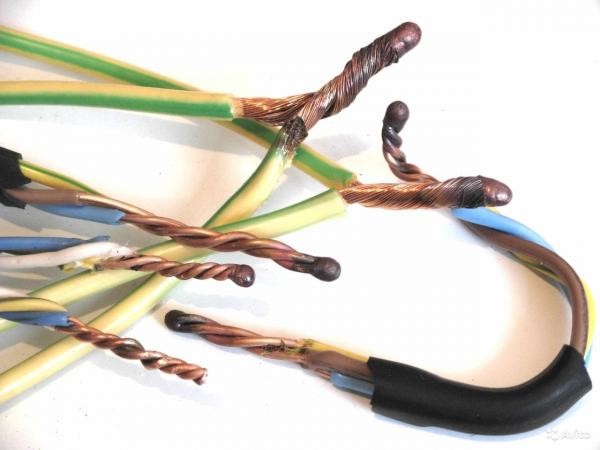
There is one more point to which you need to pay attention. If sockets or fixtures change frequently, if they are periodically repaired, then it is better to use a stranded copper cable in the wiring of the house. During installation and repair work, the cable itself is bent, so a rigid wire may simply not withstand multiple bends. Although the quality of modern sockets and lamps is quite high, so there is no need to talk about their frequent failure. We add that the best option for household electrical wiring is a two-core hard cable.
For information! Rigid new copper wire can withstand 80 bends, old no more than 15.
In industrial installations
In electrical installations and networks of industrial type, rigid and flexible cables are used in strictly designated places. For example, a single-core cable is installed in substations, in circuits for connecting stationary equipment, in auxiliary networks. Flexible is most often used to create switchboard circuits, in instrumentation and A cabinets, in relay protection boxes, and so on. although here, too, a hard cable can be used. But for sure, where it cannot be applied - these are the moving parts of various machine tools and special equipment. The simplest example is an electric hoist.
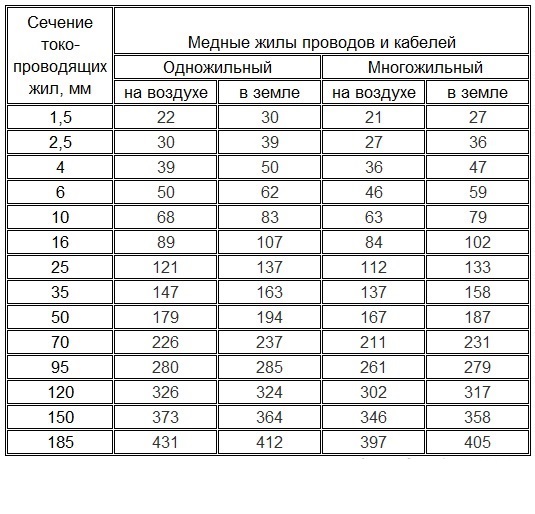
As for all kinds of cabinets, there are certain strict requirements here. If microprocessors are installed in them, then it is only necessary to connect them to other devices with multi-core copper wire. The thing is that microprocessors, or rather, their clips, are very delicate elements. So a hard wire can make them unusable.
And the last one in this section. Rigid cables of large cross-section have a small radius of curvature. And if at the facility there is a need to install an electrical network at an angle close to a straight line, then it is better to give preference to a flexible stranded one. By the way, copper cables have seven classes of flexibility. And the higher the class, the higher the flexibility. Accordingly, a single-core wire belongs to the first class. In addition, such a classification fully confirms the price range of products. That is, the higher the class, the higher the price.
Additional Information
Everything seems to be clear from the above information. But ordinary people may have questions that relate to varieties of flexible copper wires. After all, there are a large number different types where, for example, winding wire for electric motors is single-core (enamelled copper), but it bends perfectly. What category does it belong to? In this particular case, this copper wire is rigid, but since it has a small cross section, it bends quite simply. Although the number of its bends is also limited.
Concerning design features flexible copper wires, it is necessary to pay attention to their insulation. Typically, these wires have an outer rubber insulation. It is this material that maintains the flexibility of the product. Of course, under the influence of various loads, rubber quickly fails, but manufacturers guarantee 30-35 years of operation. And for cable products of this type, this is a good result.

For example, let's take a look at what layers the KG copper flexible wire consists of.
- So, the cores themselves are twisted wires of small diameter. The section shape is round. Each core is insulated with polyethylene terephthalate. By the way, each core has its own color, which facilitates installation work, especially the connection of electrical sections.
- All cores are insulated with a common insulating layer. It is made of rubber (natural or butadiene material can be used).
- Next, the insulation is treated with talc.
- The last layer is rubber belt insulation.
This design of the KG cable allows it to be used almost everywhere. The wire is not afraid of solar radiation, high humidity, temperature changes. By the way, there are varieties that determine the operating conditions. For example, if the cable marking contains the designation "ХЛ", then such a copper cable can be used in conditions low temperatures. It uses isoprene rubber as insulation. If the letter “T” is present in the marking, then its insulation is made of antiseptic rubber. Such a wire can withstand high temperatures and humidity, colonies of harmful microorganisms (fungi and mold) will not form on the rubber insulation.
Electrical, electronic communication equipment, television, numerous devices household appliances and other devices of industrial equipment are actively used in all areas of our activity. Cables, wires and cords are used for power supply, control and information exchange between individual systems, units, each of which has its own functional purpose. In order for the work to be carried out as efficiently as possible, cables and wires are made with different designs and technical characteristics, according to their intended purpose. In the article we will tell you how the wire differs from the cable and cord, consider the main characteristics.
The difference between a cable and a cord
For some people, this terminology is not fundamental and little understood, professional electricians clearly understand the difference. Wire - the classic version of the wire is one metal core without insulation, copper, aluminum, nichrome, depending on the purpose of the wire. Wires can be stranded, when several thin wires are pulled together in one twist. Such options are actively used for the transmission of electricity between power transmission towers through twisted aluminum wires.
Aluminum bare, stranded wire for power lines. It is without insulation, electricians call it naked or bare.
Single wires with a solid or stranded core can be insulated with PVC or rubber braid.
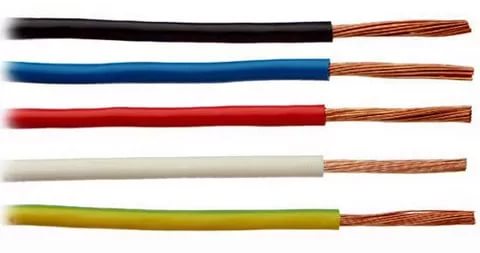
For additional protection and ease of installation when laying in wells, cable channels, strobes on the walls of structures in one insulating bundle, 2 - 4 wires can be located in a row. Sometimes separately insulated wires are placed in a thin PVC sheath, cloth yarn. Thus, the wires are divided into:
- naked, which do not have insulation, such wires cannot be laid in structures underground, only along overhead line;
- Isolated applied to electrical connection individual boards in electrical equipment, installation of electrical wiring in residential buildings and other structures. These wires are not recommended to be laid along an overhead line and it is strictly forbidden to lay them underground, especially under water. The insulation is not able to withstand high mechanical loads, and is not tight enough.
A cable is a product with a complex multilayer structure of insulation and shielding, containing one or more conductive cores. The wires in this design, in addition to individual insulation, are enclosed in a dense, hermetic sheath. Some models have a shielding braided mesh over the entire diameter of a thin metal wire. Sometimes the screen is made with foil or steel tape, lead tube. In most cases, the outer sheath of these cables is a layer of durable PVC insulation. Read also the article: → "".
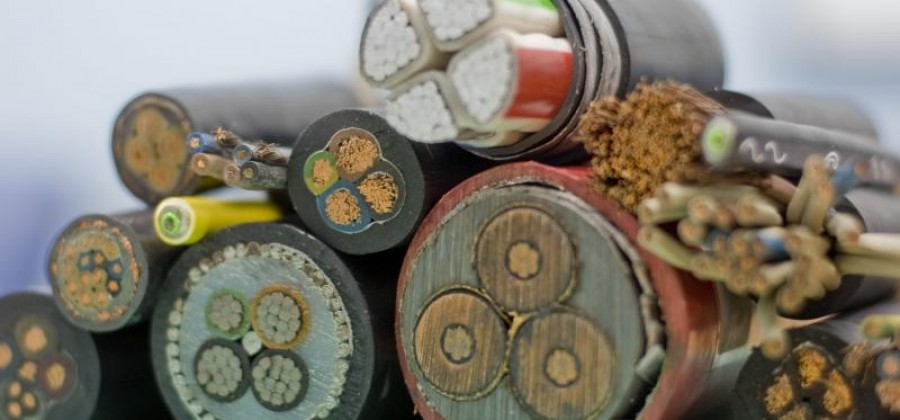
In cables intended for laying underground or under water, a bituminous layer is applied between the metal screen and the outer sheath to increase waterproofing. Compared to wires, power cables can use solid copper conductors of large cross section of 240 mm 2 or more. Strong and hermetic insulation allows the use of cables in wider areas with various conditions gaskets. Armored cables are used for lines of force, information transfer, are laid underground, water, on the walls of structures and through the air.
In domestic conditions, an armored cable is used very rarely, it is laid underground from transformer substation to the switchboard of a private house. Cables without an armored sheath with a cross section of no more than 16 mm 2 are led from the overhead line; this is quite enough for the power consumed in a private house.
In addition to power cables, manufacturers make brands for various purposes, which are massively used at the household level:
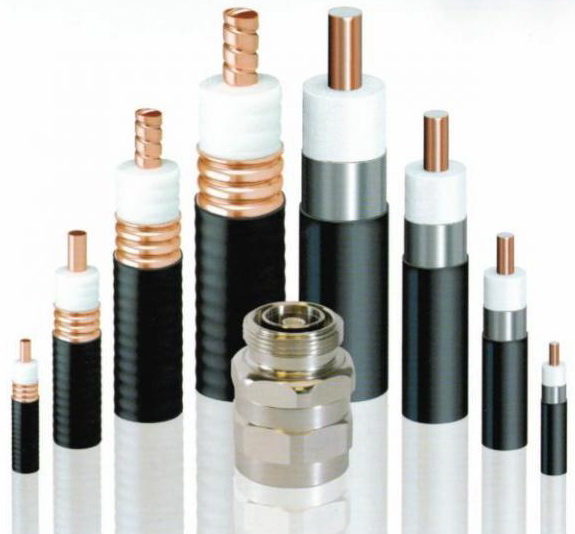
- Twisted-pair cable for transmitting signals over a local computer network or to a PC from a provider, for connecting equipment in communication, alarm and video surveillance systems
- Fiber optic cables perform all the same functions as twisted pair cable, but their bandwidth is much higher. This cable requires special equipment to match the transmitted signals.
These are one of the most popular types of cables; in production, communication enterprises, many other types of cables and wires are used, the purpose and specifications which require a separate description.
Types of individual cables and specifications
All cables can be divided into two groups:
- Power for the transmission of electricity supply to electrical installations;
- Control for the transmission of control signals, telemetry, telephone communications, digital video signals, local connections computer networks.
NYM brand power cables
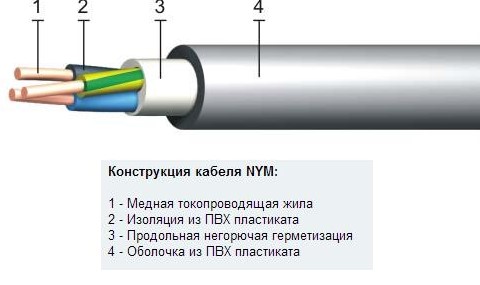
NYM-J 3×1.5 - cable with three cores, cross section 1.5 mm2 + yellow-green ground
It is used at domestic and industrial facilities for the distribution of electricity in lighting and socket networks, between electrical equipment in enterprises. Refers to class 1 electrical safety, marking is carried out depending on the manufacturer, domestic product or German:
- N - standards according to German designations;
- Y - PVC insulation material;
- M - the presence of the outer shell;
- The absence of the letter "A" indicates that the conductors are copper, by default;
- In some models, the letter J is present in the designation, indicating the presence of a ground wire, in addition to the main phase and neutral conductors.

Multi-layer cable construction:
- Copper conductors;
- PVC - insulation on each individual conductor, colored insulation, always present, yellow wire with a green stripe for grounding and white wire with a blue stripe as a neutral conductor. The remaining wires can be of any color.
- The middle layer of insulation is a shell made of vulcanized rubber;
- PVC outer sheath with additives that make it non-flammable.

Very high quality cable, appreciated by consumers for long term operation and a wide choice of section. Read also the article: → "".
Brand power cables KG
The main scope of this model is the connection to power sources of mobile electrical installations or their individual elements. The cable is very flexible, withstands vibration, and numerous kinks, so it is preferred to operate in these conditions.

Council number 1. Do not make mistakes when connecting wires to the terminals of the moving element, be sure to secure the end of the outer sheath of the cable, securely fasten it with a clamp to the mechanism body. Otherwise, the wires will come off and may short to each other or to the case.
All conductors are copper twisted from thin wire, the insulation of the conductors and the sheath is rubber with non-combustible components. The outer layer of insulation is resistant to UV rays and sealed, so it can be used both in the sun and in conditions of high humidity. Widely used in the shipbuilding industry for the river and sea fleet, for various climatic conditions:
- In a temperate climate;
- cold;
- Tropical.
Core colors of KG cable, export version (color markers indicate the number and colors of core insulation):
Table of weight, outer diameters and weight of copper cable KG:
|
Cable KG Cross section in mm and number of cores |
Outer Ø mm | Weight per 1 km/kg | Copper weight 1km \kg | |||
| 1 x 2.5 | 6,7 | 80 | 22,2 | |||
| 1x4 | 8,0 | 110 | 35,6 | |||
| 1x6 | 9,0 | 150 | 53,4 | |||
| 1 x 10 | 11,1 | 230 | 89 | |||
| 1 x 16 | 12,4 | 310 | 142,4 | |||
| 1 x 25 | 14,6 | 450 | 222,5 | |||
| 1 x 35 | 16,4 | 590 | 311,5 | |||
| 1x50 | 19,0 | 820 | 445 | |||
Manufacturers make a cable up to 4 cores + grounding section up to 120 mm 2 weight and diameter data are indicated on the marking of the outer sheath.
Power cable brand VBBSHv
There are three main symbols in this abbreviation:
- B - vinyl insulation of cores;
- BB - armored with double galvanized steel tape, wound along the cable in a spiral, while the joints overlap;
- Shb - outer sheath, PVC hose (vinyl);
- The absence of "A" indicates that the wires in the cable are copper (default).
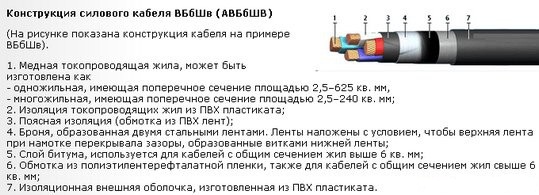
VBBShvng - the prefix "NG" means belonging to the insulation of non-combustible components.
Purpose and main characteristics: used to transmit electricity AC voltage up to 660V or 1000V depending on the cross-section of wires. It is laid from the substation to the consumer's switchboard underground, if necessary, installation along the walls of the building and through the air between the supports is possible.
In the structure of the cable there can be 1-5 solid or twisted stranded wires with a cross section of 1.5 - 240 mm 2, the weight of these models is in the range from 345 to 11300 kg / 1 km. Wires are marked with colored insulation:
- Yellow with green stripe grounding;
- White with a blue stripe neutral wire;
- The rest are for connection to the phases.
Cables with a wire cross section of more than 70 mm 2 can be marked with numbers. Read also the article: → "".
Control cables for transmission of control or information signals
One of these types of cable is coaxial construction, used to transmit signals from antennas to transceiver equipment. Used in CCTV systems cable television, in computer local networks at distances up to 500 m without amplification equipment.
RG6 cable. It is laid to connect satellite, television systems, the signal is transmitted through two conductive elements:
- Rigid central conductor, steel Ø02mm, tinned with an outer layer of copper;
- Screening sheath in the form of a grid, includes 48 thinnest aluminum wires Ø 0.12mm;
- Foamed polyethylene between the central and shielding conductor;
- PVC outer sheath.

RG6 cable construction. Characteristic impedance for antenna cables this type is 75 ohms.
Cable PK 75 is a domestic analogue of RG6, the shielding sheath is made of copper wire, the central core is copper Ø 072 mm. KVP series cables are used to transmit control signals and information in local computer networks, in telephone communications. They include in their design 2-4 twisted pairs of copper wires Ø 0.52 mm, in polyethylene color insulation. All pairs are pulled together by a common PVC sheath.

Very often mistaken when using coaxial cables for local computer networks, especially at distances of more than 500m, it is possible, but you need to amplify the signal, this extra costs. The transmission rate of information over the KVP cable is greater, and the signal attenuation is less.
Tip number 2 Pay attention to the cables VVG and KVVG they are very often confused, appearance really similar. But the internal structure and purpose are different;
- Vvg – power cable for power transmission, not intended for underground installation;

- Kvvg – control, for transmitting control signals to individual elements in electrical installation systems. Laid in secondary, low-voltage circuits, has a high degree of insulation protection, can be laid underground and in aggressive conditions environment. 3 - the cores are twisted together, have colored insulation, one blue and one red is required.
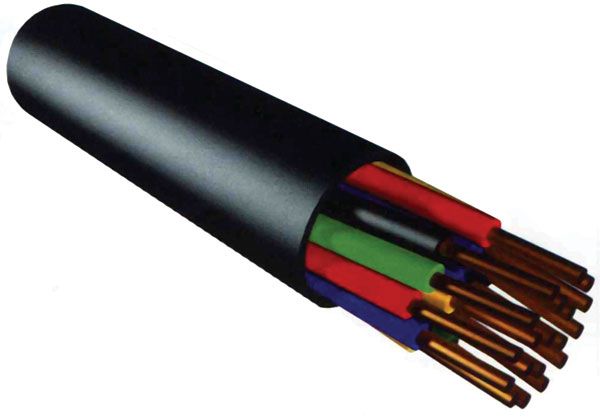
In the VVG cable, all conductors can be of the same color and placed in parallel, the ground conductor can be yellow-green and of a smaller Ø. The thickness of the insulation on the wires and the overall sheath is 0.2 mm more. There are other design and technical differences that cannot be determined by appearance. So be careful, they often make a mistake using the control cable as a power cable, the probability of breakdown and short circuit is very high.
Types of individual wires and specifications
All wires are marked, the first letter P denotes a wire, the second P denotes a shape - flat. If aluminum conductors are placed before the letters PP, copper conductors are not designated by default. The following letters indicate the type of insulation, rubber, PVC or polyethylene. The last digits determine the number of cores and the size of the section in mm 2.
PUNP - one of the most popular wires for laying a network in rooms, for lighting and sockets. (Wire, universal, flat, 3x1.5 three cores 1.5mm each). The main parameters of various grades of PUNP:
| Quantity and section in mm 2 | External thickness and width in mm | kg/1km. |
| 2x1 | 3.6x5.5 | 38 |
| 2 x 1.5 | 4.0 x 6.5 | 52 |
| 2x2.5 | 4.4 x 7.0 | 72 |
| 2x4 | 5.0 x 8.4 | 107 |
| 2x6 | 5.5 x 9.4 | 147 |
| 3 x 1.5 | 4.0 x 8.7 | 78 |
| 3x2.5 | 4.4 x 9.8 | 108 |
| 3x4 | 5.0x12 | 160 |
| 3x6 | 5.5 x 13.5 | 219 |
The wire according to the declared characteristics is very good, in reality 80% of the products do not meet the parameters. Many manufacturers are clearly hacking, the cross section can be 20-30% less, the thickness of the polyethylene insulation is less than 0.5 mm, the composition of the PVC outer sheath does not meet the fire-fighting requirements of a non-combustible material. All this leads to electrical breakdowns of insulation and even to fire, we must not chase cheapness, but carefully check, require certificates of conformity and guarantees.
PBPPg (PUGNP) – in its design, it is similar to PUNP, with the exception of the vein structure. The wires are copper, but not solid, twisted from numerous thin strands. This gives this model more flexibility and eliminates the possibility of a break. All these wires can be laid on concrete and brick walls, under plaster, but not recommended on wooden surface. Despite the declared characteristics that the insulation does not support combustion.

PPV / APV wire. The scope of this wire is slightly wider than the PUNP brand. In addition to the installation of a lighting and socket network, it can be used to connect three-phase electrical installations operating from AC voltage 380V to 450V, and DC up to 1000V. with a frequency of 400 Hz.
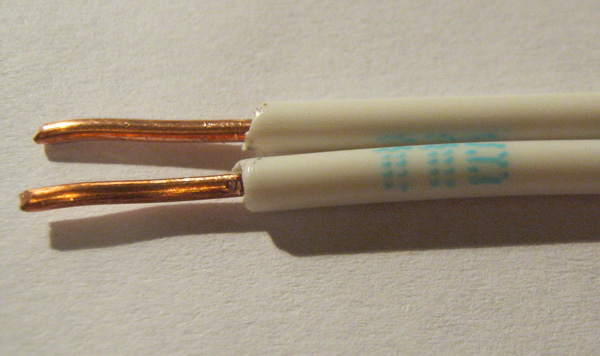
The abbreviation stands for the above principle:
- P - wire;
- P - flat;
- B - polyvinyl chloride, a type of insulating material PVC;
- This is followed by numbers indicating the number of cores and the size of their cross section in mm 2. Subsequent numbers may indicate the maximum allowable voltage;
- APV - means that the wire is with aluminum conductors.
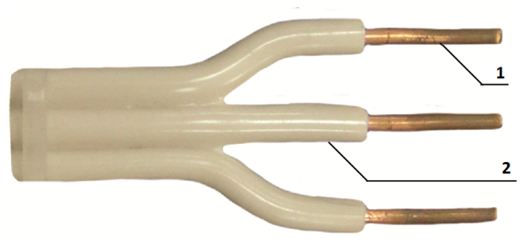
When operating electrical equipment great importance is given to the cross section of the wires, it is chosen so that the wires can withstand the current load for a long time. Manufacturers make PPV of various sections before connecting the wire, make sure that it can withstand the amount of current passing through the circuit.
Permissible current of the PPV wire for various wire cross-sections:
| Cross section in mm 2 | 2 - cores | 3- core |
| Permissible current in Amperes | ||
| 1.5 | 18 | 16 |
| 2.5 | 23 | 22 |
| 4 | 30 | 28 |
If the permissible current loads are exceeded, the PVC insulating layer begins to melt from the heating of the wires, this can lead to short circuit. Permissible wire temperature during operation is not more than 70 ̊С. Negative ambient temperatures are allowed up to -50 ̊С, but installation work without heating can be carried out no lower than -15 ̊С, otherwise the insulating layer and the cores themselves may crack and break. The bending radius when laying the wire should not exceed 10 Ø of the wire, especially in cold weather.
The mass of the PPV wire, depending on the cross section and the number of cores:
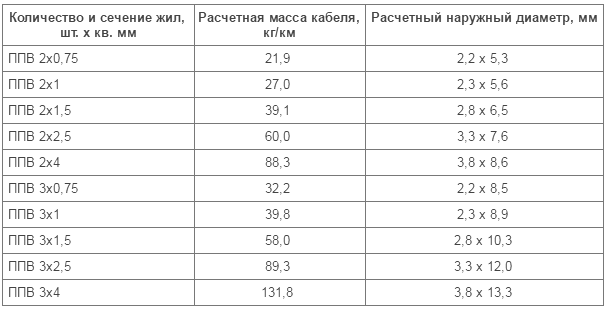
With proper operation, even in the harshest conditions, the wire will last at least 15 years.
PV 1 (PuV) and PV 3 (PuGV). These wires are used for wiring in buildings, connecting electrical equipment, connecting elements in switchboards in networks with alternating voltage up to 450 V.
- PV 1 - has a monolithic copper core;
- PV 3 - a core twisted from many very thin wires, as a result of which flexibility is significantly increased;
- PVC insulation.
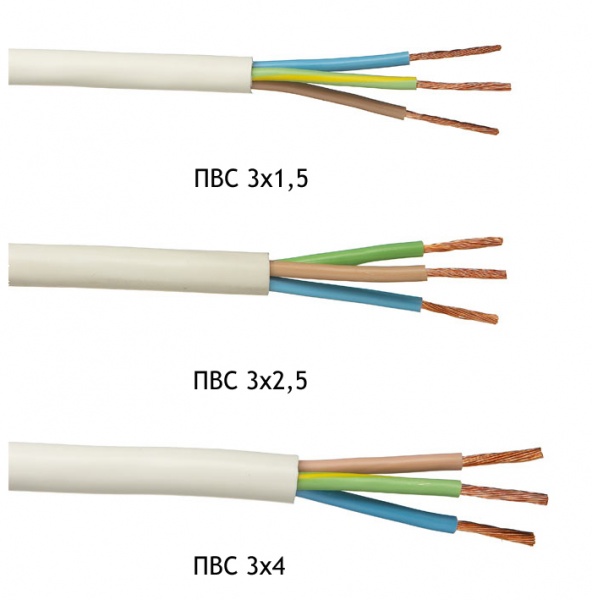
The structure of the wire is classic, solid or flexible stranded wires, each insulated with a PVC layer under a common vinyl sheath. PVA marking means:
- P - wire;
- B - vinyl insulation;
- C - functional purpose "Connecting".
It is very convenient to use the wire to connect individual elements of 380V electrical equipment to power sources, focusing on the color insulation of the wires. The outer shell has White color, brown, black or red wires are connected to the phases, blue is used as a neutral conductor. In some versions, there is a yellow-green conductor for grounding electrical installations. PVA is very actively used for the installation of socket and lighting networks, it is considered very reliable and durable, a large selection in terms of the number of cores and cross section:

Double PVC insulation of increased thickness allows the use of the wire in high humidity conditions.
SHVVP. Used as a cord for connecting household appliances, washing machine, soldering irons, hair dryers and other equipment operating on 220/380V voltage. It is deciphered in the classical form:
- Ш - cord with flexible stranded wires;
- B - vinyl insulation of wires;
- B - vinyl overall shell;
- P - flat (wires in shells are located side by side in the same plane.
Specifications of ShVVP:
| Number of wires section, mm 2 | Core insulation layer in mm | Shell insulation thickness, mm | Operating load current, A, | weight kg/km |
| 2x0.5 | 0,5 | 0,6 | 1 | 26,5 |
| 2x0.75 | — | — | 2,5 | 33,6 |
| 3x0.5 | — | — | 1 | 38,5 |
| 3x0.75 | 0,5 | 0,6 | 2,5 | 49,3 |
Since people are constantly working with the cord, using household appliances, especially such as a soldering iron, kettle or hair dryer, the insulation is made very reliable. Insulation resistance at 70 ̊С - 0.010 MΩ, less is not allowed.
Frequently asked Questions
Question number 1. What wire to replace the old cord on the iron?
ShVVP - with three cores, section 1.5 - 2.5 mm 2;
Question number 2. What cable is better to lay the RG6 or RK-75 video surveillance system?
It doesn't matter much, both options are with good characteristics. Which cable is more available in your conditions and cheaper.
Question number 3. They say that PUNP is a bad cable, which one should be used for internal wiring in the house?
According to the declared characteristics, very good cable, but in recent years the rating has fallen sharply, many fakes or manufacturers are hacking, the section is smaller, the insulation is thinner. Use PVS or PPV.
Question number 4. What wire to put on an electric walk-behind tractor?
ShVVP cord, more better cable KG, cross-section depending on power, but not less than 1.5 mm 2 and the number of cores depends on the electric motor, single-phase or three-phase.
To send email energy in electrical networks wires and cables are used, and flexible cords are used to connect various electrical devices.
Cables, wires, cords - what are they, what are their similarities and differences? The basis of all these products is a current-carrying core, rigid if it consists of one wire and flexible if there are a lot of wires that make it up.
The wire.
An uninsulated (bare) wire is one current-carrying core, without insulation. Bare, aluminium, steel-aluminum, copper, steel wires
used for outdoor networks.
Insulated aluminum and copper wires are used for electrical wiring inside buildings. Cotton yarn impregnated with vulcanized rubber, PVC plastics and other plastic polymers are used as insulation.
Cord.
Cord - a wire consisting of two or more flexible insulated cores enclosed in a common sheath. In life, we constantly encounter electrical cords - it is with their help that our household electrical appliances usually connected to the mains.
Cable.
The cable consists of one or more insulated cores enclosed in an additional protective sheath, sometimes multilayered.
At first glance, there are clear definitions that bring some clarity.
However, in fact, in practice, guided by them, it is often very difficult to draw a clear line between all these much-needed (and very diverse) electrical products.
For example, outwardly, it is very difficult to distinguish the wire PUNP from cable VVG, it is not easy to answer the question why PVA is a WIRE, not a cable, or at worst, a cord. In order not to puzzle oneself in vain, it remains to take for granted the possible (and seeming) contradictions and inconsistencies, leaving them on the conscience of the development engineers.
Standard- |
Long-term permissible current loads on wires. (Amperes.) |
||||||
| isolated wires. |
Aluminum isolated wires. |
Non-isolated |
|||||
open |
Three |
open |
Three |
Aluminum |
Steel. |
||
| 1,5 | 23 | 17 | - | - | - | - | - |
| 2,5 | 30 | 24 | 24 | 19 | - | - | - |
| 4,0 | 41 | 35 | 32 | 28 | 50 | - | - |
| 6,0 | 50 | 42 | 39 | 32 | 70 | - | - |
| 10,0 | 80 | 60 | 55 | 47 | 95 | - | - |
| 16,0 | 100 | 80 | 80 | 60 | 130 | 105 | - |
| 25,0 | 140 | 100 | 105 | 80 | 180 | 135 | 60 |
| 35,0 | 170 | 125 | 130 | 95 | 220 | 170 | 75 |
| 50,0 | 215 | 170 | 165 | 130 | 270 | 215 | 90 |
| 70,0 | 270 | 210 | 210 | 165 | 340 | 265 | 125 |
| 95,0 | 330 | 225 | 225 | 200 | 415 | 320 | 135 |
| 120,0 | 385 | 290 | 295 | 220 | 485 | 375 | - |
The cable here is equated to three wires laid in one pipe.
The use of any materials on this page is allowed if there is a link to the site





